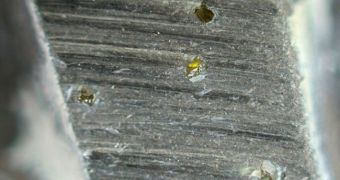Violent cosmic collisions between carbon particles and shock waves produced by supernova explosions may be responsible for the creation of DNA-sized diamonds in outer space. Experts first found these structures inside meteorites that survived atmospheric reentry, and crashed to the surface.
This discovery is very interesting in context. Lately, astronomers conducted a number of studies on the role that supernovae played in generating heavy chemicals and other materials, which currently permeate deep space.
By analyzing the tiny diamonds, experts believe they may be able to gain a better understanding of how the stellar explosions occur in the first place. Supernovae are believed to have been some of the most important actors in seeding the early Universe with chemicals heavier than hydrogen and lithium.
Diamonds that occur on Earth are formed inside the mantle, under extreme pressures and temperatures. They take billions of years to be pressed into coherent, nearly unbreakable arrangements. Unlike these, space diamonds can appear in just a tiny fraction of a second.
In a paper published in the latest issue of the esteemed journal Physical Review Letters Curtin University materials scientist Nigel Marks says that the transformation is amazing. “I never would have imagined this was possible,” he goes on to say.
A series of computer models the expert and his team compiled indicates that carbon particles that contain cosmic dust can spontaneously form DNA-sized diamonds if they are crashed together at speeds exceeding 10,000 miles (16,093 kilometers) per hour, Daily Galaxy reports.
The simulations showed that a collision at this speed forced the carbon molecules to flatten and squeeze together, forming the hexagonal structure that is characteristic to diamonds. Interestingly, only collisions that take place within a certain range of speeds can lead to the formation of nanoscale diamonds.
What is even weirder is that most cosmic collisions at this scale appear to take place within, or close to, that range. “There's a huge message embedded in the nanodiamond. [Astronomers] just couldn't figure out what it was,” Marks concludes.

 14 DAY TRIAL //
14 DAY TRIAL //